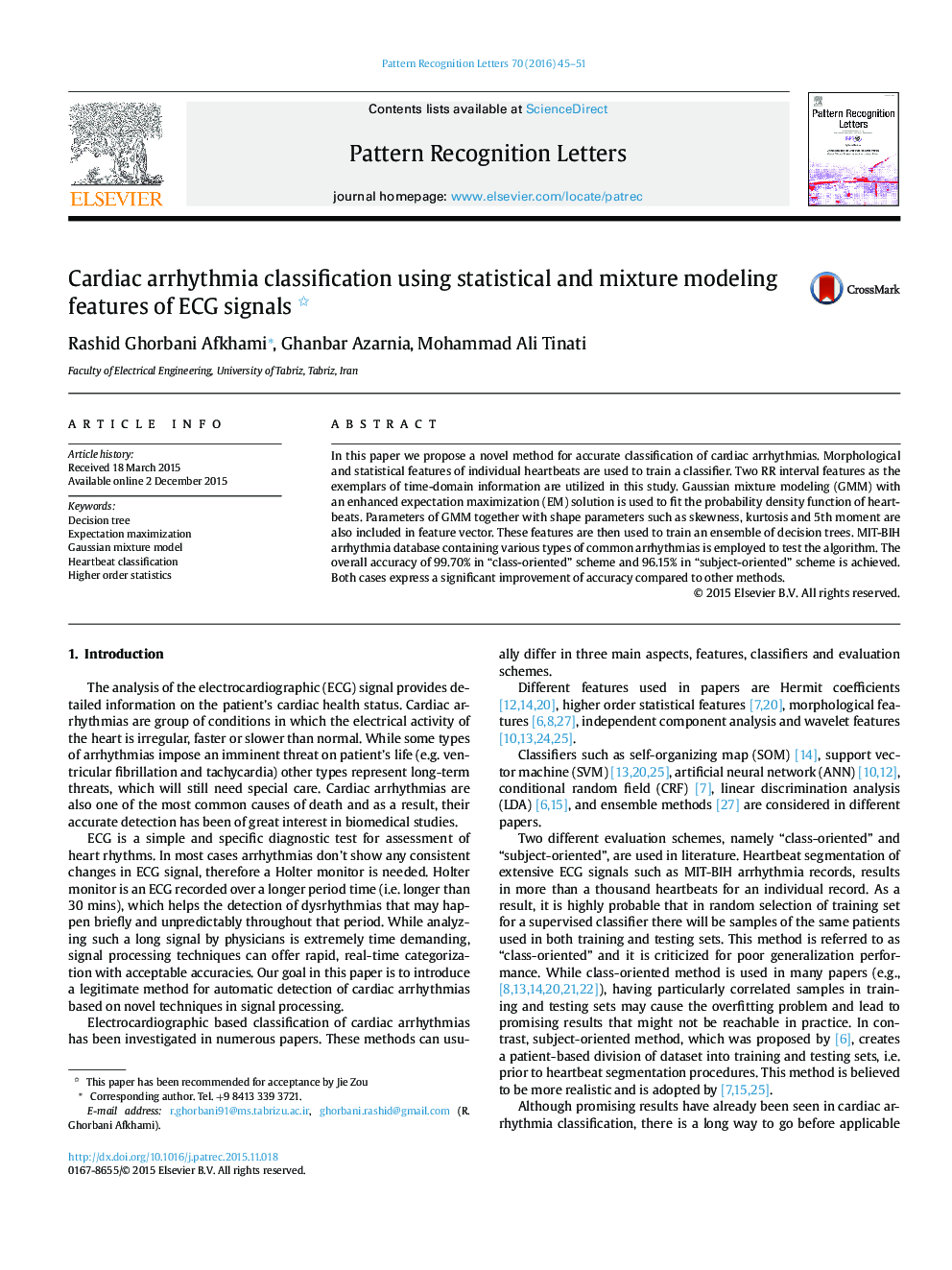| کد مقاله | کد نشریه | سال انتشار | مقاله انگلیسی | نسخه تمام متن |
|---|---|---|---|---|
| 533674 | 870151 | 2016 | 7 صفحه PDF | دانلود رایگان |
کلمات کلیدی
1.مقدمه
2. پیشینه
2.1 آمارهای مرتبه بالاتر
2.2 مدل ترکیبی گاووسی
2.3 درخت های تصمیم
2.4 یادگیرنده های اثرکلی
3. روش
شکل 1. بلوک دیاگرام روش مطروحه برای طبقه بندی آریتمی قلبی
جدول 1. اطلاعات پایگاه داده آریتمی MIT-BIH
جدول 2. برچسب زنی توصیه شده AAMI با مجموعه تمرینی (DS1) و مجموعه آزمایشی (DS2) استفاده شده در طرح سوژه محو
3.1 مجموعه داد
3.2 پیش پردازش داده
شکل 2. نمونه های Post-RR و خصایص RR-پیشین برای سه کلاس انتخاب شده در آریتمی
3.3 استخراج خصیصه
شکل 3. نمونه ها در خصایص آماری بالاتر برای کلاس های انتخاب شده آریتمی
شکل 4. تراکم احتمالاتی 1000 ضربان قلب تصادفی انتخاب شده
3.4 طبقه بندی
4. ارزیابی و نتایج
4.1 متریک های عملکردی
4.2 ارزیابی کلاس محور
شکل 5. میانگین ضربان قلب برای 6 آریتمی مختلف و پارامترهای تخمین GMM برای هر کدام
جدول 3. نتایج برای طرح طبقه بندی سوژه محور
جدول 4.نتایج برای طرح طبقه بندی کلاس محور
4.3 ارزیابی سوژه محور
جدول 5. نتایج رقابتی طبقه بندی کلاس محور
جدول 6.ماتریس ابهام برای طرح سوژه محور
جدول 7 .نتایج رقابتی طبقه بندی سوژه محور
4.4 نتایج
5. جمع بندی
• Gaussian mixture modeling is used to fit the probability density function of heartbeats.
• Expectation maximization algorithm estimates the parameters of statistical model.
• Skewness, kurtosis and 5th moment of ECG signals express the shape parameters.
• RR interval information represents the time-domain characteristics of ECG signals.
• An ensemble of decision trees are used to perform the final classification.
In this paper we propose a novel method for accurate classification of cardiac arrhythmias. Morphological and statistical features of individual heartbeats are used to train a classifier. Two RR interval features as the exemplars of time-domain information are utilized in this study. Gaussian mixture modeling (GMM) with an enhanced expectation maximization (EM) solution is used to fit the probability density function of heartbeats. Parameters of GMM together with shape parameters such as skewness, kurtosis and 5th moment are also included in feature vector. These features are then used to train an ensemble of decision trees. MIT-BIH arrhythmia database containing various types of common arrhythmias is employed to test the algorithm. The overall accuracy of 99.70% in “class-oriented” scheme and 96.15% in “subject-oriented” scheme is achieved. Both cases express a significant improvement of accuracy compared to other methods.
Journal: Pattern Recognition Letters - Volume 70, 15 January 2016, Pages 45–51
